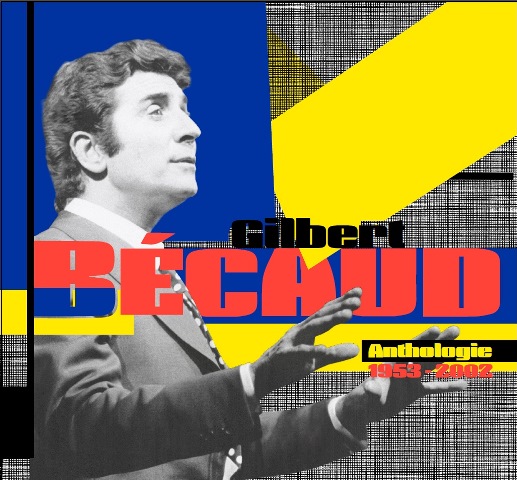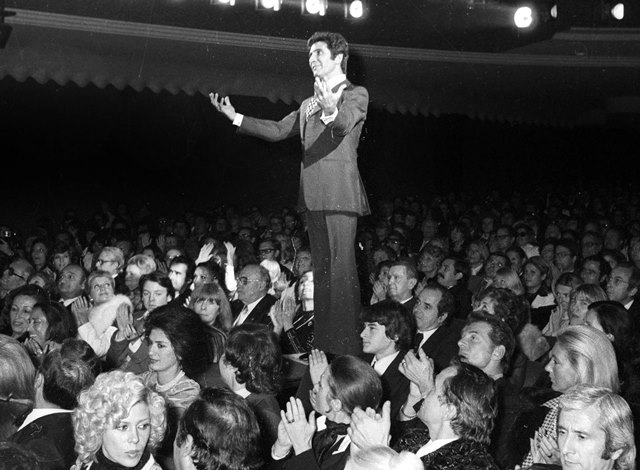Reissue CDs Weekly: Gilbert Bécaud | reviews, news & interviews
Reissue CDs Weekly: Gilbert Bécaud
Reissue CDs Weekly: Gilbert Bécaud
Dauntingly massive box set dedicated to 'Monsieur 100,000 Volts’

Anthologie 1953–2002 is a monster. A 20-disc set spanning almost 50 years, it tracks one of France’s most beloved singers and songwriters. Gilbert Bécaud died in December 2001, but songs from his posthumously released Je Partirai album are included. Fitting, as his music lives on and the release of this box set marks the 15th anniversary of his death.
Outside France, Bécaud is less well known. Though his “A Little Love and Understanding” single charted in Britain in 1975, he did not make a Charles Aznavour-style crossover to mainstream recognition in the Anglophone world. He’s never been given belated appreciation and the subsequent commodification as happened with Serge Gainsbourg. For France, he doesn’t quite fit the received notion of a chansonnier: the poet-like singer-songwriter with a strong personality standing apart from that of other performers. Figures likes Georges Brassens, (Belgium’s) Jacques Brel and Léo Ferré had instantly identifiable styles. Bécaud’s idea of branding was wearing a suit and tie, the latter usually a trademark spotted one. And, as Anthologie 1953-2002, makes abundantly clear, Bécaud is not instantly classifiable.
 Bécaud was about his songs, a characteristic theartsdesk has previously noted. In their English-language versions, “What Now My Love”, "Let It Be Me" and “The Day the Rains Came Down” have become standards. Writing with Neil Diamond recognised that Bécaud’s songwriting had international appeal. He was also adaptable. During the Sixties’ yé-yé era he wrote for straight pop singer Richard Anthony and the earthy former rock ‘n’ roller Eddy Mitchell. Getting a handle on the essence of Bécaud has always been difficult.
Bécaud was about his songs, a characteristic theartsdesk has previously noted. In their English-language versions, “What Now My Love”, "Let It Be Me" and “The Day the Rains Came Down” have become standards. Writing with Neil Diamond recognised that Bécaud’s songwriting had international appeal. He was also adaptable. During the Sixties’ yé-yé era he wrote for straight pop singer Richard Anthony and the earthy former rock ‘n’ roller Eddy Mitchell. Getting a handle on the essence of Bécaud has always been difficult.
Bécaud was also about his powerful live presence. In person, he was dynamic and always electric. Indeed, he was known as “Monsieur 100,000 Volts.” The man born François Silly in 1927 took a little while to get there. Initially, he was not a performer and wrote for film and for others. Edith Piaf was an early adopter of his songs. His first release came in 1953, which is where Anthologie 1953–2002 begins.
The first recording heard is “Les Croix”, the topside of his first single, recorded on 2 February 1953. It is lush and, considering that French records were often still rickety sounding in the mid Sixties, surprisingly so. Fully orchestrated, with his deliberate delivery floating above strings, piano and muted woodwind, it sounds as if plucked from a film soundtrack. “Il Faut Bâtir ta Maison”, recorded at the same session, is more sprightly. It could have played over a bustling scene in a film: of people scurrying to work, or a shot tracking through a busy market. The lyrics of “Il Faut Bâtir ta Maison” were by Pierre Delanoë, Bécaud’s most long-term and principal collaborator. Delanoë had also written for Piaf and was as adept as Bécaud: Johnny Hallyday and Michel Sardou recorded his words.
 As Anthologie 1953–2002 continues it becomes clear this adaptability suggests what Bécaud was about. Broadly, his recordings were orchestrated chanson-pop but he had an enviable capacity to insert a quintessentially French approach to songwriting into any style. In 1966, on disc seven’s “Le Petit Oiseau de Toutes les Couleurs” a then-contemporary Petula Clark-ish pep and swing colours the song but it remains as cinematically delivered – akin to a sung narration – as songs from ten years earlier or ten years later. This, then, is the essence of Bécaud: his ability to cast himself as a chronicler; the singer who bridges the gap between singer and audience or listener. The connection he makes is instant. It is hard to think of a British singer with a similar bearing. Perhaps, although he had an utterly different approach to song, Anthony Newley? (Pictured left, Gilbert Bécaud meets his audience in 1973)
As Anthologie 1953–2002 continues it becomes clear this adaptability suggests what Bécaud was about. Broadly, his recordings were orchestrated chanson-pop but he had an enviable capacity to insert a quintessentially French approach to songwriting into any style. In 1966, on disc seven’s “Le Petit Oiseau de Toutes les Couleurs” a then-contemporary Petula Clark-ish pep and swing colours the song but it remains as cinematically delivered – akin to a sung narration – as songs from ten years earlier or ten years later. This, then, is the essence of Bécaud: his ability to cast himself as a chronicler; the singer who bridges the gap between singer and audience or listener. The connection he makes is instant. It is hard to think of a British singer with a similar bearing. Perhaps, although he had an utterly different approach to song, Anthony Newley? (Pictured left, Gilbert Bécaud meets his audience in 1973)
For anyone who did not grow up with Bécaud, Anthologie 1953–2002 is daunting. Not only are there more than 400 tracks, the final three discs compile previously unreleased material and live recordings. Setting these in context is nigh impossible. It is also not a collection of his complete works. “A Little Love and Understanding” is not included and only four of his English-language recordings are heard. The striking design and evident care taken with the production (the remastering was undertaken from scratch) are set off against the missed opportunity the text represents. The box contains two hardback books: the second contains the CDs and the annotation. The first book is heavy on large-format photos, whole pages given over to graphics and a surface-level account of his life. In-depth text focusing on the music and the contents of the box set itself would have been much better.
Obviously, this is no entry point into Bécaud. But, no doubt, it will be in many French Christmas stockings. Only 4,000 though, as it is a numbered, limited edition. For non-French folks, beyond being stuffed with songs begging to be discovered, Anthologie 1953–2002 brings a welcome reminder that we know less than we should about our closest continental neighbour.
Share this article
The future of Arts Journalism
You can stop theartsdesk.com closing!
We urgently need financing to survive. Our fundraising drive has thus far raised £49,000 but we need to reach £100,000 or we will be forced to close. Please contribute here: https://gofund.me/c3f6033d
And if you can forward this information to anyone who might assist, we’d be grateful.

Subscribe to theartsdesk.com
Thank you for continuing to read our work on theartsdesk.com. For unlimited access to every article in its entirety, including our archive of more than 15,000 pieces, we're asking for £5 per month or £40 per year. We feel it's a very good deal, and hope you do too.
To take a subscription now simply click here.
And if you're looking for that extra gift for a friend or family member, why not treat them to a theartsdesk.com gift subscription?
more New music
 theartsdesk on Vinyl 93: Led Zeppelin, Blawan, Sylvester, Zaho de Sagazan, Sabres of Paradise, Hot Chip and more
The most extensive, wide-ranging record reviews in the galaxy
theartsdesk on Vinyl 93: Led Zeppelin, Blawan, Sylvester, Zaho de Sagazan, Sabres of Paradise, Hot Chip and more
The most extensive, wide-ranging record reviews in the galaxy
 Suzanne Vega and Katherine Priddy, Royal Albert Hall review - superlative songwriters
Two brilliant voices fill the Royal Albert Hall
Suzanne Vega and Katherine Priddy, Royal Albert Hall review - superlative songwriters
Two brilliant voices fill the Royal Albert Hall
 Kali Malone and Drew McDowell generate 'Magnetism' with intergenerational ambience
Young composer and esoteric veteran achieve alchemical reaction in endless reverberations
Kali Malone and Drew McDowell generate 'Magnetism' with intergenerational ambience
Young composer and esoteric veteran achieve alchemical reaction in endless reverberations
 Benson Boone, O2 London review - sequins, spectacle and cheeky charm
Two hours of backwards-somersaults and British accents in a confetti-drenched spectacle
Benson Boone, O2 London review - sequins, spectacle and cheeky charm
Two hours of backwards-somersaults and British accents in a confetti-drenched spectacle
 Midlake's 'A Bridge to Far' is a tour-de-force folk-leaning psychedelic album
The Denton, Texas sextet fashions a career milestone
Midlake's 'A Bridge to Far' is a tour-de-force folk-leaning psychedelic album
The Denton, Texas sextet fashions a career milestone
 'Vicious Delicious' is a tasty, burlesque-rockin' debut from pop hellion Luvcat
Contagious yarns of lust and nightlife adventure from new pop minx
'Vicious Delicious' is a tasty, burlesque-rockin' debut from pop hellion Luvcat
Contagious yarns of lust and nightlife adventure from new pop minx
 Music Reissues Weekly: Hawkwind - Hall of the Mountain Grill
Exhaustive box set dedicated to the album which moved forward from the ‘Space Ritual’ era
Music Reissues Weekly: Hawkwind - Hall of the Mountain Grill
Exhaustive box set dedicated to the album which moved forward from the ‘Space Ritual’ era
 'Everybody Scream': Florence + The Machine's brooding sixth album
Hauntingly beautiful, this is a sombre slow burn, shifting steadily through gradients
'Everybody Scream': Florence + The Machine's brooding sixth album
Hauntingly beautiful, this is a sombre slow burn, shifting steadily through gradients
 Cat Burns finds 'How to Be Human' but maybe not her own sound
A charming and distinctive voice stifled by generic production
Cat Burns finds 'How to Be Human' but maybe not her own sound
A charming and distinctive voice stifled by generic production
 Todd Rundgren, London Palladium review - bold, soul-inclined makeover charms and enthrals
The wizard confirms why he is a true star
Todd Rundgren, London Palladium review - bold, soul-inclined makeover charms and enthrals
The wizard confirms why he is a true star
 It’s back to the beginning for the latest Dylan Bootleg
Eight CDs encompass Dylan’s earliest recordings up to his first major-league concert
It’s back to the beginning for the latest Dylan Bootleg
Eight CDs encompass Dylan’s earliest recordings up to his first major-league concert

Add comment